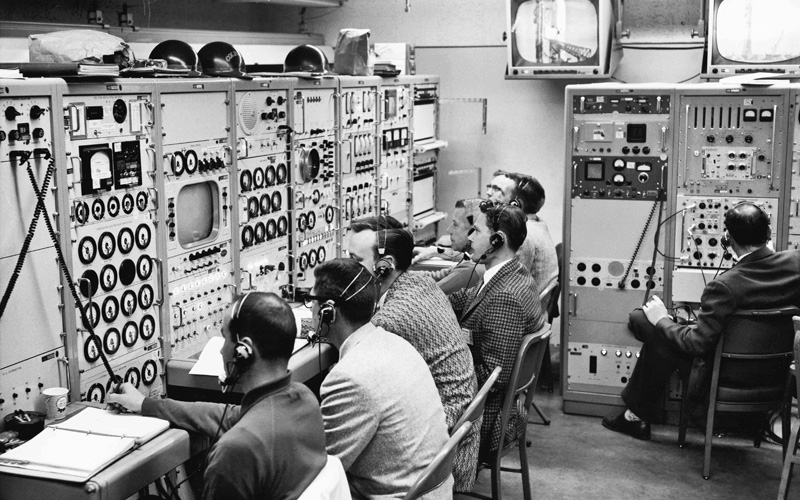Aerospace’s early years were defined by the ambitious projects that are now synonymous with the early days of space exploration. As one of its first projects, the corporation helped convert the Atlas, Titan, and Minuteman missiles into space boosters. Aerospace helped develop the pilot safety program for Project Mercury, which improved the reliability of the Atlas launch vehicles and helped ensure the safety of the astronauts.
Along with working on verification guidance equations, factory inspections, and final launch stand verifications at Cape Kennedy, Aerospace was part of the team involved in man-rating CLV-1, the first Gemini launch vehicle. Aerospace also helped to support the first manned Gemini flight—a five-hour mission carried out by astronauts Gus Grissom and John Young.

The corporation worked on some of the earliest space-based reconnaissance programs, including Discoverer and Corona, both of which were satellite programs designed to take photos from space. Aerospace also began working on in Project 621B, a precursor to the GPS program.
During the early years, the company’s first president, Dr. Ivan Getting, set the tone for many of the corporate values that are still central to Aerospace’s culture. Getting placed a high value on objectivity and technical excellence, and he recognized that Aerospace’s employees were the talent that was central to the corporation’s success.
Aerospace Expands Its Reach
At the close of the 1960s, with the moon landing accomplished, the tenor at Aerospace shifted. Aerospace continued to play an important role in space, but the corporation also began to expand its work in the civil and commercial sectors. The corporation tackled projects in fields ranging from medicine and transportation, to energy and the environment. During this time, Aerospace also did work for the Law Enforcement Assistance Administration, including important research on body armor that aided in the development of Kevlar for use in bulletproof vests.

Aerospace provided critical support to the Department of Energy’s Strategic Petroleum Reserve program in the late 1970s. The aim of the project was to create a store of petroleum that would protect the country against disruptions in the oil supply.
Another large project that Aerospace helped to tackle in the 1970s was the development and operation of the space shuttle. As this ambitious project ramped up, data obtained in Aerospace’s analyses was incorporated into the design specifications. Among other things, the corporation helped to determined how large the vehicles’ cargo bay needed to be and the necessary payload capacity, it helped create a design for a device that would measure slight deformations that arose from uneven solar heating of the orbiter’s structure, and it also helped to test and evaluate the shuttle to make sure that it would meet the Air Force’s requirements.

Aerospace was also involved with President Ronald Reagan’s Strategic Defense Initiative (SDI), popularly known as Star Wars. In the early 1980s, SDI was conceived as a way to protect the United States from nuclear ballistic missile attacks using ground-, air-, and space-based systems.
Aerospace played an important role in developing many technological components of SDI: surveillance and radar, satellite autonomy, survivable systems (a system’s ability to withstand attacks or other adverse circumstances), thermal control, tribology (the study of friction, wear, and lubrication between surfaces), magnetosphere physics, electronics, and hypergolic propellant handling.
The Global Positioning System
During the Persian Gulf War of 1991, GPS first received widespread publicity. Though not fully operational at the time, the system had a significant impact on military operations, enabling allied forces to coordinate their movements in the featureless Iraqi desert and achieve a rapid victory with a minimum of casualties.

Just over a decade later, GPS was used with similar success in the war in Afghanistan, a country renowned for its difficult terrain. Although the development of GPS can be traced back to the military demands of the Cold War era, it has gone far beyond its initial defense applications and now extends into the daily lives of millions of civilians, who use it for commercial, recreational, and educational purposes.
In 1992, as a member of the GPS team, Aerospace shared the nation’s most prestigious aeronautical award, the Collier Trophy. The citation accompanying the award called GPS “the most significant development for safe and efficient navigation and surveillance of air and spacecraft since the introduction of radio navigation 50 years ago.”
The award was a capstone to three decades of difficult development work, remarkable innovation, and tireless advocacy by Aerospace personnel, often at a time when only a handful of people recognized the system’s enormous potential.
Since the 1990s, Aerospace has played a key role in developing next-generation launch vehicles, providing space station assessments and technical support for various satellite systems. In recent years, Aerospace has contributed to advancements in satellite communications, space-based surveillance, and defense systems while also supporting environmental monitoring satellites. Aerospace continues to assist with launch vehicle programs and the enhancement of global intelligence and reconnaissance capabilities, while also supporting efforts to modernize military communication systems.

